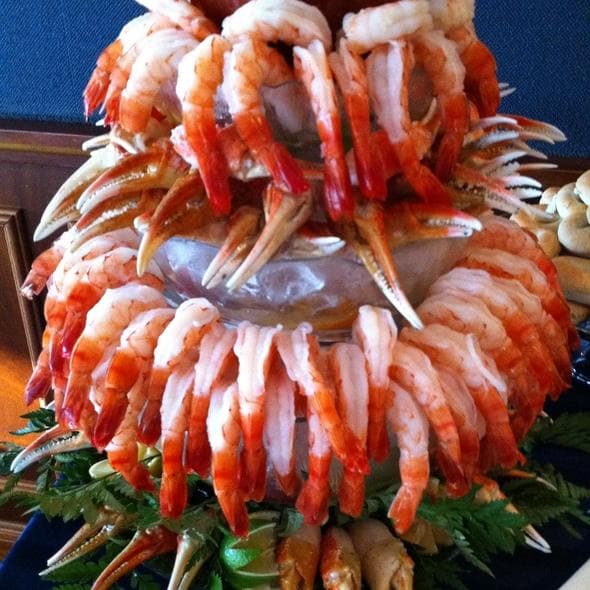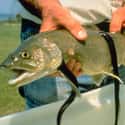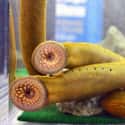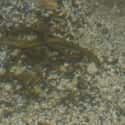-
(#7) Sea Lampreys Nearly Collapsed Commercial And Recreational Fishing
During the 1940s and 1950s, an explosion of sea lamprey wreaked havoc to the Great Lakes. The invasive species excessively fed on the lake trout, whitefish, and chubs that dwelled there. Because a single adult lamprey can consume a massive amount of fish in its lifetime, a multitude of lamprey feeding on the lake's fish caused a huge epidemic for the commercial and recreational fishing industries. In fact, before the epidemic, more than 15 million pounds of lake trout could be harvested on a yearly basis from the Great Lakes. However, after the invasion, this number fell dramatically and by the 1960’s only 300,000 pounds was harvested from the lakes.
-

(#12) Lampreys Die After Spawning
In spring, sea lampreys makes their way to freshwater riverbeds for breeding. Gathering in small groups, the females will lay between 35,000 to 100,000 eggs, which the male fertilizes externally. After fertilization, the eggs are buried in shallow nests within the stony riverbed. For sea lampreys to reproduce during the spawning season, they stop eating to conserve energy. As reproducing adults, sea lampreys no longer need their digestive track, and so it deteriorates to make room for their reproductive system. This weakens the lamprey and allows its body to become invaded by a fungus, which immediately kills the lamprey shortly after spawning.
-
(#4) Parasitic Sea Lamprey Destroy The Environment
The sea lamprey is considered to be a parasitic fish because it bores holes into its prey while feeding on their blood and bodily fluids, slowly killing their prey and damaging the species overall survival rate. In fact, a single parasitic lamprey can kill over 40 pounds or more of fish in its lifetime.
The impact that sea lampreys pose to the ecosystem greatly threatens the lives of the many fish it prefers to feed on, such as the lake sturgeon. Because of the sea lamprey's horrendous feeding habits on lake sturgeons, the sturgeon has been marked on the threatened and endangered species list in both New York and Vermont.
-
(#3) Lampreys Have Amazing Regeneration Powers
Lamprey fish possess the unique ability of regeneration within their bodies. They share this ability with various creatures such as crabs, sea stars, salamanders, scorpions, and some lizards to name a few. These creatures can regenerate their systems, appendages, or bodily fluids in some form. If a lamprey’s spinal cord becomes completely severed, leaving the creature immobile, they can recover to full mobility again in 10 to 12 weeks. Because the sea lamprey can regenerate some of their long nerve connections, they can heal the injured part of their spinal cord.
-
(#13) Not All Lamprey Fish Are Parasitic
The sea lamprey is not the only type of lamprey living in the world. In fact, there are over 40 different species of lampreys that exist on earth. Four of these species are native to North America. And while the invasive, parasitic lampreys get the most attention, not all lamprey fish are parasitic or invasive to the environment. The northern brook and American brook lamprey are non-parasitic. Unlike river and sea lamprey, brook lamprey never become parasitic as adults; they simply mate and die. Non-parasitic lampreys don't deplete the fish population and actually live in balance with the food chain.
-

(#5) They're Really, Really Hard To Stop
Because of the invasive nature of the sea lamprey and after the destruction they caused during the 1940s, conservationists searched for a method to cull the lamprey population. The barriers that were first used to stop the lampreys from reaching the lakes proved to be ineffective. It wasn’t until much later, in the latter half of the 1950s, that biologists created an effective poisonous chemical to control the sea lamprey population, called Lampricide. Lampricide is non-toxic to humans or other aquatic life and only works to kill lamprey in their larval stage. Since then, new techniques such as male lamprey sterilization and pheromone communication methods have been used and prove to be effective as well.
New Random Displays Display All By Ranking
About This Tool
We can not deny that lampreys look very disgusting. They have no upper and lower jaws, and their cylindrical mouths are full of teeth, which is one of the characteristics of ancient fish ancestors. Scientists have confirmed that lampreys are the most primitive vertebrates in the world, but this sea creature has hardly evolved and still maintains its original form and way of survival. They rely on these sharp teeth to suck blood from other fish, and even parasitize other big fish.
We should know that lampreys are not fish, because they look terrifying and become the prototype of many monsters in movies. In fact, lampreys are also edible and taste good. You could find 14 disgusting facts about lampreys in this random tool.
Our data comes from Ranker, If you want to participate in the ranking of items displayed on this page, please click here.













